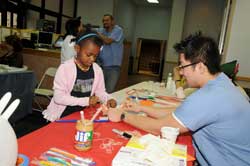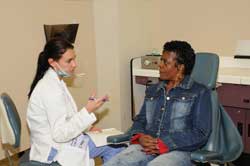Dental students and faculty work to improve access to care
| CONTACT: Renee Cree <rencree@temple.edu> 215-707-1583 |
| North Philadelphia was recently classified as a dental health provider shortage area by the Pennsylvania Department of Health. This means that for the roughly 240,000 people who live in this part of the city, there simply aren’t enough dentists to treat them all. But thanks to a new $1.14 million grant from the American Dental Association, the Maurice H. Kornberg School of Dentistry is working to make sure its neighbors are getting the oral care they need. Last month, the school signed an agreement with the ADA to become the urban site of its Community Dental Health Coordinator pilot program, through which up to 12 members from surrounding neighborhoods will learn to provide their communities with dental care services and help them navigate the health system to gain access to oral care services. |
 Courtesy David M. Branson Photography
At a health fair on Halloween, dental student Allan Wun shows a young girl how to floss properly. This event was one of several by the school aimed at improving access to care and
|
| “Our aim is to ensure that the coordinator is able to bridge the gap between local cultures and dental health care systems, helping community members navigate social and bureaucratic barriers that prevent them from accessing dental health services,” said Amid Ismail, dean of the dental school, and one of the architects of the program. Upon completion of their training, the coordinators will promote prevention of oral disease and work under supervision to provide preventive services such as screenings, fluoride treatments, placement of sealants and temporary fillings and simple teeth cleanings. In addition, they will link patients to health providers by coordinating appointments and helping patients become eligible for charitable dental programs. The school’s participation in the ADA’s program is the latest effort to improve access to oral health care for North Philadelphia residents. Already, students and faculty spend well over 13,000 hours a year in the community, giving free screenings at schools and churches and holding and attending neighborhood health fairs. The school has also carried out a series of meetings with community leaders and members, during which attendees listed a number of barriers to care, such as poor knowledge of oral health practices, cost of care, low awareness of available dental resources and poor connections to opportunities in the field of dentistry. Based on some of these concerns, the school recently held an open house event designed to reach both parents and children to improve their access to care. |
|
 Photo Courtesy David M. Branson Photography
Dental student Christin Massaro talks with a patient about her oral health during a free screening. North Philadelphia was recently classified as having a shortage of dental health providers, so the dental school plans on ramping up the number of patients it sees to help treat as many people as possible.
|
“We wanted to give people a chance to get to know the various departments at the school and the services they offer, provide information on ways to make dental care affordable and accessible and increase nutritional knowledge and also give career development guidance,” said Alexia Clarke, the event’s organizer and a research assistant at the dental school. Annually, the school’s clinic takes about 100,000 patient visits, making it the busiest clinic in the city. “But as the primary dental care provider in North Philly, this school should see more patients,” said Ismail. |
|
Which is why the school is embarking on a comprehensive plan to expand its mission and reach. School facilities and resources for faculty and staff will be the focus for major upgrading over the next five years. "We are now in the process of redefining the school’s clinical model for education and patient care to include a new system in which patients receive dental care in comprehensive care clinics," said Ismail. "This new model will streamline the patient care process, eliminate long delays and waiting times and focus on increasing the number of patients that we service." "By becoming a patient-centered institution, which means patients are first, and by providing them with superior care in all regards, we will better educate our students. In being one of the few dental schools to adopt this approach, we can enhance our students’ education so that they can become advanced clinicians with far better skills than their counterparts at other dental schools," he said. The school is also planning to work with more community members and organizations to improve access to care for a population — predominantly Black or Latino — most at risk for oral health problems. Ismail says taking the school in this new direction will help address the need for new dentists who are skilled at understanding the special and specific needs of the underserved community. “As a dentist serving in an area like this, you can’t just treat the dental problems,” he said. “You have to address the deeper, complex issues affecting people as well: employment, housing, social conditions and the lack of social supports.’’ “If you live on one side of the economic divide and don’t know the other side, you can’t really appreciate what they are experiencing or provide what they need,” he said. |
|